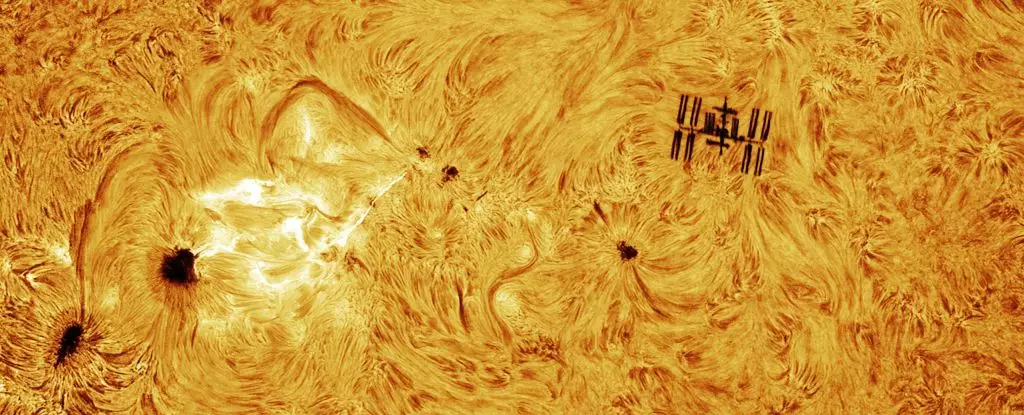Astrophotography often demands not just skill but a remarkable amount of patience and serendipity. A prime example of this is the recent achievement by Arizona-based astrophotographer Andrew McCarthy, who managed to seize a breathtaking moment while photographing the International Space Station (ISS) transiting the Sun. While images of the ISS silhouetted against celestial bodies are impressive in their own right, McCarthy’s capture transcended typical space imagery by including an active solar flare erupting in the frame. This convergence of transient cosmic phenomena highlights the dynamic and unpredictable nature of our solar system, reminding viewers of both its beauty and intrinsic volatility.
Beyond a Snapshot: The Challenge of Capturing Fleeting Events
The feat McCarthy accomplished was not simply about timing the ISS passing before the Sun, but also about contending with the ephemeral and often spontaneous solar flare. Unlike the relatively predictable orbit of the ISS—which circles Earth approximately every 90 minutes—solar flares are sudden bursts of radiation from the Sun’s surface. They can last anywhere from a few minutes to several hours, but the particular flare in this image was fleeting. Successfully photographing both events simultaneously required not only meticulous planning, cutting-edge technology, and expertise but also a bit of fortunate timing.
Tracking and capturing an ISS transit involves anticipating a brief window when the station passes in front of the Sun or Moon. This window can last less than a second, making the feat a testing challenge for even the most experienced astrophotographers. McCarthy’s approach further pushed the boundaries by dealing with the intense Arizona desert heat, employing cooling techniques such as ice packs and coolers to maintain optimal telescope performance. The complexity of the equipment setup and the precise timing underscore how astrophotography blurs the lines between art and science.
Astrophotography as Storytelling and Scientific Exploration
McCarthy’s final image, which he thoughtfully named *Kardashev Dreams*, is more than just a visually stunning photograph. It reflects a deeper narrative about humanity’s place in the cosmos and the aspirational leap towards technological sophistication, inspired by the Kardashev scale—an idea proposed by Nikolai Kardashev to classify civilizations based on their energy harnessing capabilities. The image symbolizes humanity’s tentative steps towards expanding our reach in space, hinting at future possibilities as we continue to explore and understand the Sun and its complex behavior.
Rather than merely presenting a static photo of the Sun with the ISS, McCarthy created a composite mosaic to showcase the Sun’s detailed surface and surrounding chromosphere. He integrated elements from a 2024 eclipse to transition parts of the image into black negative space, emphasizing the solar flare and the station’s silhouette against a dramatic, high-contrast backdrop. This artistic choice creates an immersive experience of solar activity, conveying the constant, energetic turmoil occurring on our star’s surface.
The Reality of Solar Flares and ISS Safety
A potential misconception might arise from such a photo: does a solar flare threaten the ISS or its crew? The answer is no, not directly. The ISS orbits Earth at around 400 kilometers altitude, whereas the Sun’s radiation and flares emanate from millions of kilometers away. However, solar flares can temporarily heighten radiation exposure for astronauts and may disrupt satellite electronics or communications. Space agencies actively monitor solar activity to protect missions and equipment, underscoring the complex interplay between solar physics and human spaceflight.
Inspiration for Aspiring Astrophotographers
Photographers wanting to capture similar ISS transits can turn to tools like Transit Finder, which predicts when and where these fleeting events occur. However, the lesson McCarthy’s work imparts goes beyond the technical. It’s a striking reminder that achieving something extraordinary requires more than preparation—it demands embracing the unexpected. Sometimes, the cosmos offers moments that no amount of planning can fully guarantee, and it is the meld of readiness and spontaneity that yields true masterpieces in astrophotography.
In celebrating this achievement, McCarthy’s image serves as a call to appreciate the remarkable intersection of human ingenuity with the raw spectacle of the universe. It’s not only a snapshot frozen in time but a symbol of the grand curiosity propelling us forward as we gaze skyward.


Leave a Reply